Point Pleasant Bridge, which opened on May 30, 1928, was a 1,460-foot suspension-type bridge that spanned the Ohio River to connect Ohio and West Virginia. This unique bridge incorporated many first-time applications, including the use of aluminum paint, which rendered its silver color. It is the reason why the bridge became known as the “Silver Bridge.”
At a little before 4:58pm on December 15, 1967, in fewer than 20 seconds, the entire suspended portion of the bridge and its two 130-foot towers collapsed and fell into the Ohio River. Of the 37 westbound vehicles on the bridge at the time, 31 fell with it — 24 into the Ohio River and 7 onto the shore. No pedestrians were on the bridge at the time.
The six remaining vehicles were on the West Virginia-side approach. They were stopped behind driver Charlene Wood, who had stopped her car when the bridge started to shake. Hoping to retreat to safety, Wood threw her car in reverse, but it stalled amid the violent shaking. As her car continued to roll backward, Wood witnessed the bridge’s progressive west-to-east collapse. Most of her car had reached the relative safety of the approach when the bridge deck fell from beneath her front wheels, leaving them hanging from the precipice. Wood’s actions prevented other vehicles behind hers from entering the side span and likely saved several lives in addition to her own.
A total of 64 people fell with the bridge (46 killed, 9 seriously injured). Only five survivors were pulled from the 42-degree river. In terms of lives lost, this incident remains the deadliest roadway bridge failure in U.S. history.
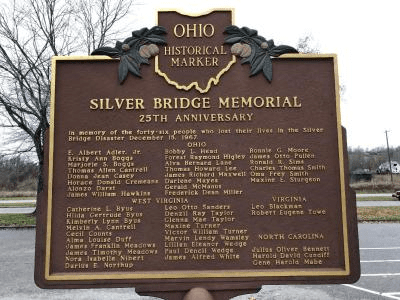
Figure 1 – Silver Bridge Memorial Plaque
The Construction of the Silver Bridge
The Silver Bridge’s origin traces back to the early 1900s to Charles Holzer, a doctor who grew tired of the time it took to reach patients on the other side of the river. Some died awaiting his arrival. Holzer eventually organized community groups to plan a bridge. Those groups eventually merged into the West Virginia Ohio River Bridge Company, with Holzer at the helm.
The design for the bridge, prepared by J.E. Greiner Company, called for an elegant suspension bridge comprised of steel wire cables, a distinct stiffening truss system and towers rigidly fixed to their supporting piers. Holzer’s company obtained $950,000 in financing and received three construction bids. The winning bid (the lowest) was from American Bridge Company (ABC) for $892,000. But in their bid, ABC proposed some changes to Greiner’s design.
Instead of suspension cables, ABC proposed the use of “chains” of eye-bars that would form links —76 in total — ranging in length from 55 to 44 feet. The eye-bars would be linked together bicycle-chain style, with 11-inch diameter steel pins passing through 27-inch diameter eyelets at the eye-bar ends to form the main part of the suspension system. From these link pin joints, high strength steel hanger bars would support the bridge deck through its truss work.
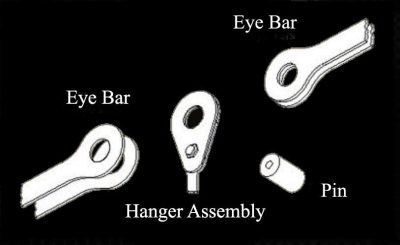
Figure 2 – Hanger Assembly
Because the eye-bar links would join with a link pin at the top of each tower, the towers could not be firmly affixed to their concrete piers. Instead, they would rock or tip on hinged joints at their base to allow for changes in chain length to accommodate varying bridge loads and temperatures — a first in bridge building in the U.S.
Another notable deviation from conventional bridge design was ABC’s plan for some of the suspension chains to double as the top chord of the trusses that stiffened the roadway deck. Ordinarily, the top chords would be in tension; however, the use of a chain as the top truss chord, when combined with pivoting bridge towers, rendered these members incapable of temporarily supporting the bridge deck in the event of other bridge system failures. Until the construction of the Silver Bridge, neither concept had ever been applied in U.S. bridge construction.
The Investigation
The sudden, complete collapse of the Silver Bridge stunned the nation and initiated the largest structural failure investigation in history, involving federal and state agencies as well as many private laboratories and corporations. It took two-and-a-half years for them to reach their final conclusions.
Meanwhile, many citizens and the media concluded that the bridge had fallen because vehicles in 1967 were heavier than they were in 1928. In the 1920s, a typical car weighed about 1,500 lbs. Trucks weighed no more than 20,000 lbs. By 1967, the average car weighed about 4,000 lbs. and trucks weighed up to 60,000 lbs.
But that was not what caused bridge’s failure. The vast majority of the weight supported by a long span bridge is that of the bridge itself. As such, the increase in live load was relatively insignificant. Despite increased vehicle weights and truck traffic, the Silver Bridge was, on December 15, 1967, carrying only 41% of its design live load and had carried much greater loads prior to that.
To begin the investigation, a 1:5 scale model of the bridge was built. This model, combined with eyewitness accounts, provided valuable clues about the bridge’s failure. To the extent possible and necessary, the bridge was reassembled, incorporating nearly all of the parts that had fallen onto the Ohio shoreline and about 60% of what had fallen into the river.
Investigators already knew that the bridge’s design meant that a complete separation of either the north or south suspension chains at any point on the bridge would have caused the collapse of the entire structure. The question remained, which failed first, and why?
All of the eye-bars from both chains were recovered, and although some were found with varying degrees of fracturing and deformation (clearly caused by the collapse), almost all of them were intact except for eye-bar 330 — its eyelet end was broken off through the link pin hole at joint C13N.
The north chain link pin joint at the top of the Ohio tower was identified as joint C15N. The next two link pin joints in the north chain heading west toward Ohio were joints C13N and C11N. The two eye-bars that formed the link between these joints were eye-bar 330 on the outside edge of the chain and eye-bar 33 on the inside (roadway) edge of the chain.
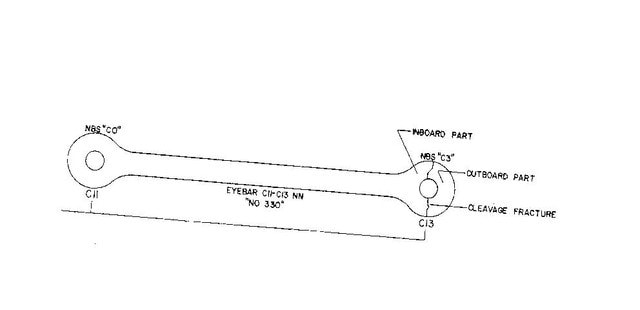
Figure 3 – Cleavage Fracture
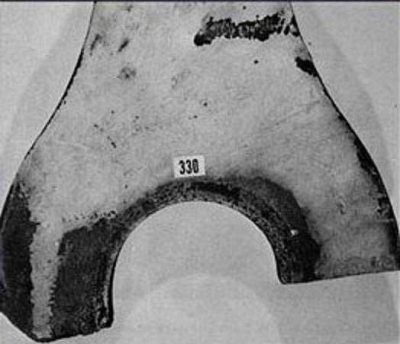
Figure 4 – Eye Bar That Broke
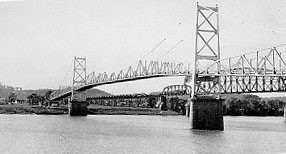
Figure 5 – Silver Bridge Before the Collapse
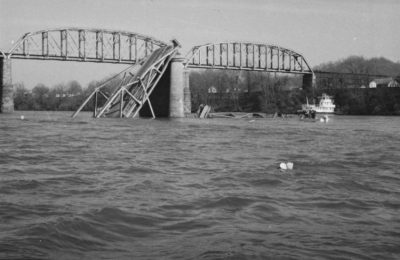
Figure 6 – Silver Bridge After the Collapse
How and Why the Silver Bridge Collapsed
The investigators were able to determine the following sequence of events that led to the bridge’s total collapse:
- The complete fracture of eye-bar 330 began with the nearly instantaneous brittle cleavage fracture from the link pin hole at joint C13N through to the bottom of the eyelet at approximately a right angle to the bar’s beam section. This initial break would likely account for the gunshot-like sound heard at the start of the bridge’s failure.
2. With its lower section broken through, the now highly overstressed upper portion of the eyelet failed in just one second.
3. This ductile deformation of the upper eyelet section immediately increased by about three inches the north chain’s effective length. This increase in length caused vertical downward deflections of two inches in the center of the main span and six inches in the center Ohio-side span.
4. The six-inch downward deflection of the north truss on the Ohio-side span initiated a rapid increase in the tension stress of the lower chord members of the north truss. This truss was able to momentarily carry a portion of the side span load by simple truss action (due to the residual tension and elastic energy of a half-million lb-ft stored in the eye-bar upper chords of the side span north truss) and prevented the immediate collapse of the Ohio-side span.
5. Now one second past the initial brittle fracture at the bottom of eye-bar 330, it took only an additional 0.2 seconds for its sister eye-bar, number 33, to slide off the now-tilted link pin at joint C13N and completely sever the north suspension chain.
6. At this time (1.2 seconds from the initiating brittle fracture of eye-bar 330), the northern trusses of both the Ohio-side span and the main span were essentially in free fall. The center of the main span had now fallen 16 feet in only one second (free fall velocity) from the time the north chain completely severed (two seconds from the initial brittle fracture).
7. Next, both the main span and the Ohio-side span began to increasingly rotate CCW (as viewed from the west). The south chain had been displaced toward the north by the continuing northward tilt of the Ohio tower, which by this time, was 30 feet north of its normal position at its top.
8. Only four seconds after the initial brittle fracture at eye-bar 330, both towers had tilted or buckled to the extent that the south chain provided no support. By this point, the Ohio-side span had already collapsed and the main span and West Virginia-side span both completed their falls within an additional second.
9. Finally, the West Virginia tower fell — toward West Virginia and slightly downstream.
A mere 8 to 10 seconds had elapsed from the initial brittle fracture of eye-bar 330 to the total silence of the completely fallen Silver Bridge.


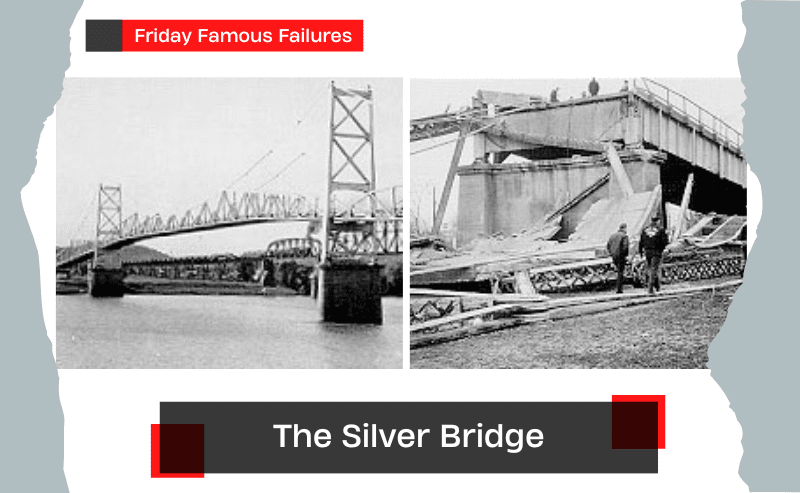
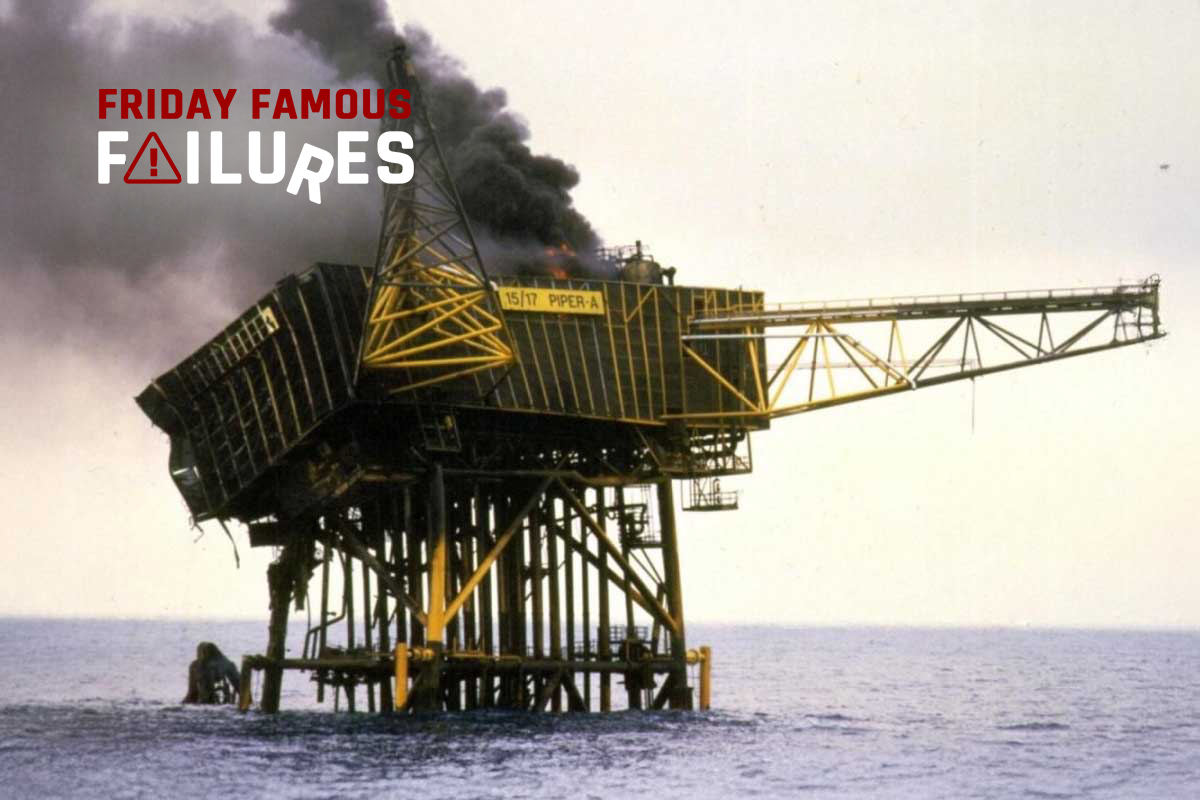
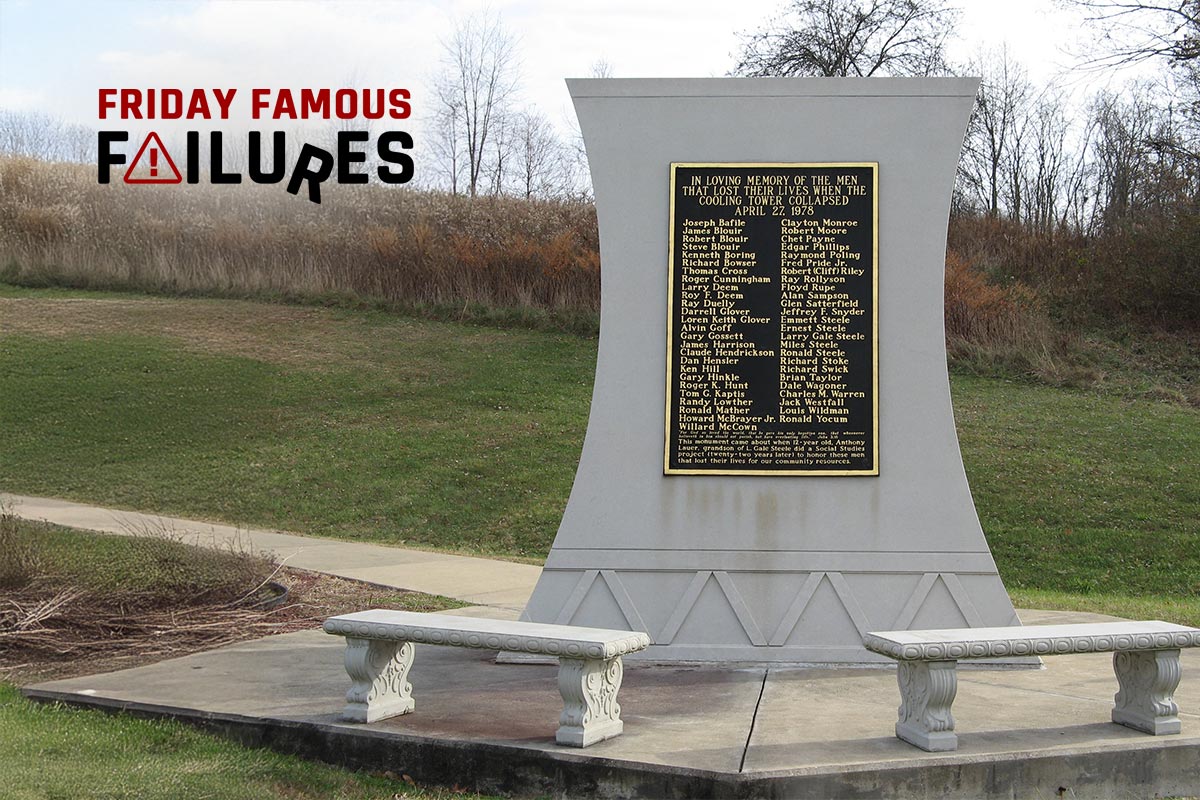
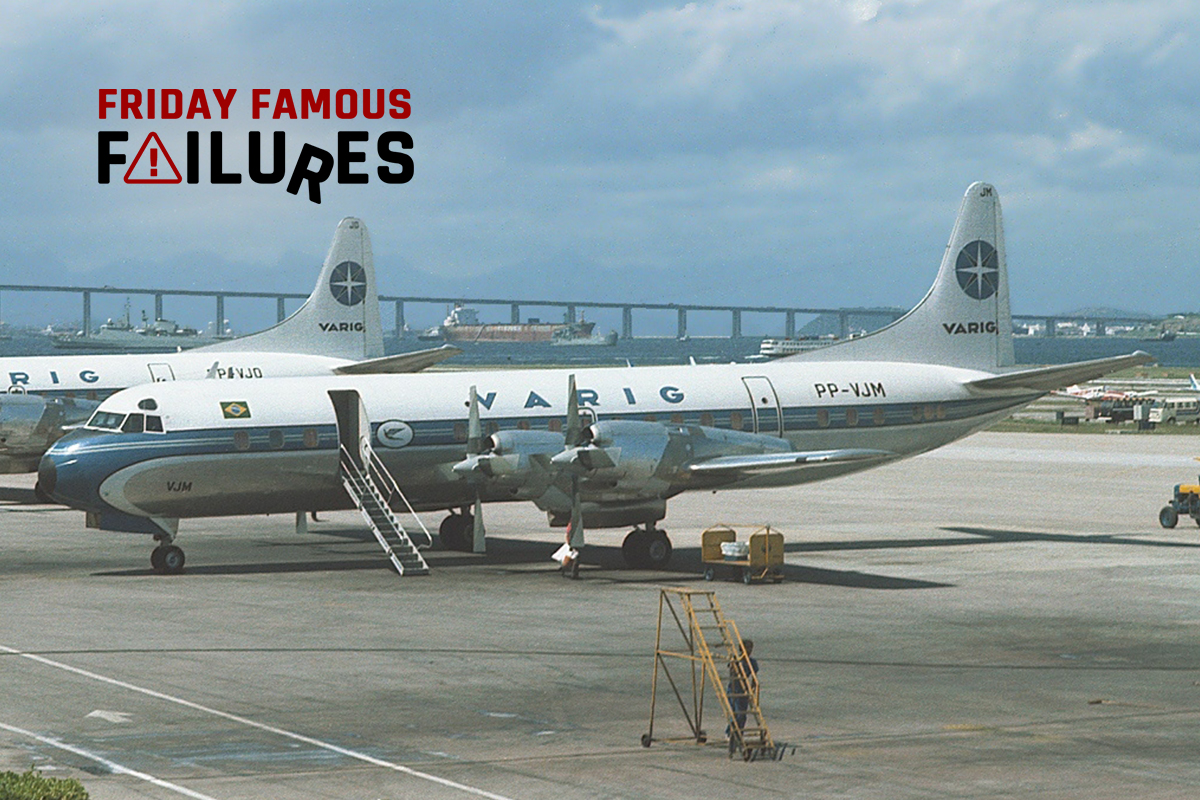



Leave A Comment